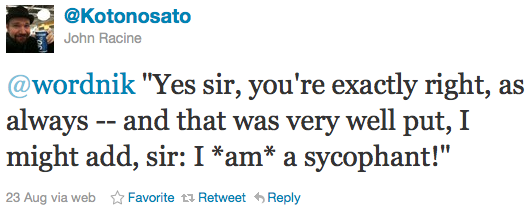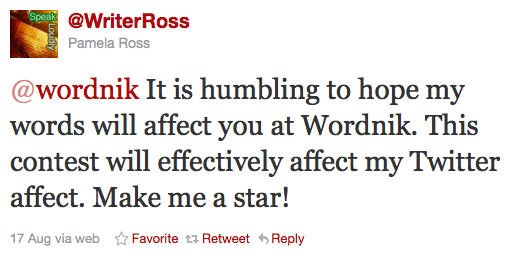Yesterday we talked about the first R of the three: reading, readers, and books. Today we’re onto the second: [w]riting.
Nowadays many of us write by typing and texting (type comes from the Greek typos, “dent, impression, mark, figure, original form,” while text comes from the Latin texere, “to weave, fabricate”), but what about plain old writing by hand?
The word write comes from the Proto-Germanic writanan, “tear, scratch,” since before paper, writing was scratched on everything from stone to clay to wax. A synonym for write, scribe, comes from the Latin scribere, “to write.” Scribere gives us a slew of writing and describing-related words: scrivener, script, scribble, Scripture and scriptorium, “a writing-room; specifically, the room set apart in a monastery or an abbey for the writing or copying of manuscripts” (manuscript, by the way, originally mean “a book, paper, or instrument written by hand,” and contains the Latin manus, “hand”).
A postscript is a little note written or printed after the fact; superscript means “written over or above the line”; and subscript means “written beneath.” Prescriptions are scribbled by doctors before patients may obtain certain medicines. Circumscribe means to “to write or inscribe around” or “to mark out certain bounds or limits for.” Transcribe means to “to copy out in writing” from one document over to another. Sans-serif, “a printing-type without serifs, or finishing cross-lines at the ends of main strokes,” is made up of sans, French for “without,” and the English serif, which may come from the Dutch schreef, “a line, a stroke.”
Another root meaning “to write” is graphein, which is Greek in origin and gives us scads of writerly and describing words. Graphology is “the study of handwriting regarded as an expression of the character of the writer.” Chirography is “the art of writing; a particular or individual style of handwriting; the art of telling fortunes by examining the hand,” with chiro meaning “hand” in Greek. Calligraphy is the art of beautiful handwriting (calli comes from the Greek kallos, “beauty,” and is related to calliope, literally “beautiful voice”). Typography is “the art of composing types and printing from them” (during which you may make a haplography). Cacography is bad handwriting or spelling, with kakos Greek for “bad, evil,” while orthography is the act or study of correct spelling, with orthos meaning “straight, true, correct, regular” in Greek.
Perhaps you spotted some graffiti (from the Italian graffiare, “to scribble”) on your way to work today as a stenographer (the Greek stenos means “narrow”). Or perhaps you’re famous and had to stop to sign some autographs (from the Greek autographos, “written with one’s own hand”). Or better yet, maybe you’re a famous lexicographer (contains the Greek lexikon, “wordbook”) and are compiling, along with a dictionary, your autobiography or your blogography, if you’re so inclined.
If you’re practicing cryptography (the Greek kryptos means “hidden, concealed, secret”), you may want to use the ancient Greek writing system, boustrophedon, which means literally “turning like an ox while plowing,” due to the way “in which the lines run alternately from right to left and from left to right, as the furrows made in plowing a field, the plow passing alternately backward and forward.” Or perhaps you’d prefer rongorongo, “an early glyphic writing system of Easter Island, written in reverse boustrophedon and as yet undeciphered,” and Rapanuiese for “recite, declaim, chant out.” Or if you want to be understood by all, then a pasigraphy is for you.
You may know pictography (literally, “recording or describing with painting”) and definitely photography (literally, “recording or describing with light”), but how about fauxtography, “misleading presentation of images for propagandistic or otherwise ulterior purposes, involving staging, deceptive modification, and/or the addition or omission of significant context”? Or tomography, taking pictures of the inside of the body? Tomography includes the Greek tomos, “slice, section,” and is part of CAT (computerized axial tomography) scan. Then there’s topography, “the detailed description of a particular locality, as a city, town, estate, parish, or tract of land” (topos is Greek for “place”) and cartography, map-making, carta coming from the Greek khartes, “layer of papyrus.”
The ways to say writer are as myriad as ways to say write, as are writing systems, types and terms about penmanship and other scribblings, and kinds of fonts.
Tomorrow we bring you the third and last R: ‘Rithmetic. We know you’ll be counting the hours.
[Photo: CC BY 2.0 by Kevin Gessner]



